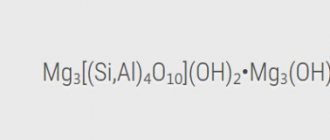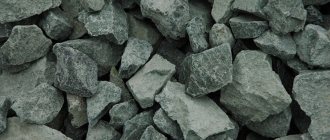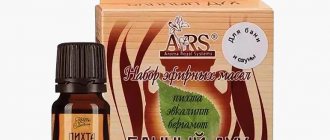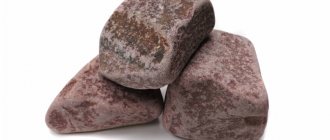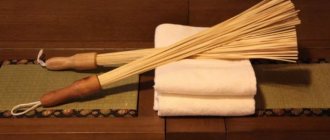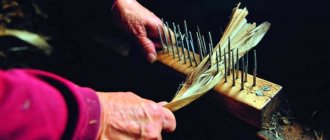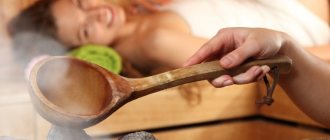Perhaps no other mineral for the heater is surrounded by so many legends and conjectures as jadeite for the bath, and to be precise from a geological point of view, jadeite, since in its pure form it is quite rare. Of course, the extremely high price of this raw material must be justified somehow. So, today we separate the wheat from the chaff, and jadeite from impurities.
History of the mineral
Jadeite stones are already described in ancient Chinese treatises. According to archaeological excavations, it was used already five thousand years ago - as a material for the most expensive dishes. The imperial baths were lined with gemstones. The ancient Chinese did not see the difference between the mineral and the similar jade.
Jadeite and jade are very similar; previously they were generally considered one stone.
Both jade and jadeite were designated by the same hieroglyph, very similar to the symbol for “emperor.” No other gem has received such an honor - in fact, it was called the main one among its precious brothers. Yellow crystals were especially valued.
The fact that jadeite is a mineral with powerful energy was known not only in China. The peoples of Central America, the Aztecs and Mayans, lined temples with it and even treated diseases. Like the Chinese, the Indians did not distinguish between the stone and its relative, jade.
“The Stone of Heaven,” as the Chinese called jadeite, was not subject to sale. Therefore, it was only able to fall into the hands of Europeans in the nineteenth century. Jewelers immediately appreciated it, and chemists finally explored its differences from jade.
Selection principles
Selection rules:
- Check with the seller about the availability of a quality certificate for minerals. If there are no documents, you need to question the choice of products.
- Real stones are cold and heat up slowly.
- Estimate the weight of minerals. He is more than he seems at first glance.
- Run the pebble across the glass surface. There should be scratches on it, and the pebble itself should not be damaged.
- Knock stone on stone. If the sound is empty, ringing, this is a fake.
If the seller refuses to provide documents, tries to embellish the quality of the minerals, and does not hand them over, it is most likely a fake.
Where is jadeite mined?
Since the times when gems were mined only in open quarries, mining methods have come a long way. Jadeite has begun to appear on the market more often, but it is still a very rare stone. There are two dozen deposits around the world. The following countries are developing:
- Burma supplies the world market with unique “imperial” stones, transparent as diamonds.
- Guatemala boasts the only deposit in the world of a bluish, truly “heavenly” stone.
- Chinese deposits are almost exhausted, but nuggets are still found.
- In Russia, jadeite is mined in two mines. The first is Borusskaya, between the Kantegir and Yenisei rivers. The second is Pusierka in the polar part of the Ural Mountains.
- Sometimes the stone is found in India, Kazakhstan, and the USA.
Siberian jadeite most often belongs to the “utility” grade. This is the cheapest type of stone used to decorate baths. The same goes for minerals from American deposits. The most prized gems are those of the “imperial” class, which are large and transparent. Their price is the same as that of emeralds.
Varieties
Jewelry jadeite is divided into three grades. During classification, the degree of transparency and the saturation of the green tint were assessed.
We recommend reading: Falcon (Hawk) eye - a powerful amulet from God
| Variety | Name | Transparency | Color |
| 1 | Imperial | Transparent, translucent, translucent | Emerald green |
| 2 | Commercial | Translucent with opaque veins | Emerald green with green |
| 3 | Utility | Opaque | Bright green |
The most prized variety in the world is the imperial variety. The price of the mineral is comparable to the cost of an emerald. Any shades of green are an indicator of high quality jadeite. The stones of the following shades are rated below:
- green-blue;
- violet;
- reddish;
- yellow;
- blue;
- gray-blue, etc.
Rarer modifications of the mineral also got their name. Chloromeranite is a dark green mineral with brown inclusions. It received this color due to the presence of iron, sodium and aluminum in its composition. Albit jadeite is a green gem with dark spots.
Physical and chemical properties
Jadeite is the entire periodic table in one gem. It may contain more than 60 different elements. The jadeite molecule and structure are similar to nepheline or albite. True, the gem is slightly denser than nepheline. Thanks to the unique crystal lattice, the stone received its main features: elasticity, thermal insulation and strength.
The mineral contains about 60 chemical elements.
Another interesting property of jadeite stone is its fibrous structure. In deposits it is usually found as part of needle-shaped or granular rocks, very rarely - as a prismatic crystal. Among the fibers there are often multi-colored inclusions, but the best specimens are completely homogeneous.
Polished jadeite looks brighter and more beautiful, and refracts sunlight better. But it is useless to subject the cheapest specimens to jewelry processing.
If the heavenly stone is heated to high temperatures, it will turn into ordinary translucent glass. Acids and alkalis can severely damage its structure. Colors can be very different, depending on the composition of the mineral. For example, Guatemalan gems received a unique green color due to chromium. Yellowish, opaque crystals become this way because iron in their composition replaces aluminum.
Talismans and amulets
Talismans and amulets made from jadeite, made by masters, have strong energy. This fact has been repeatedly confirmed by historians.
Jadeite amulets are suitable for people with obvious mental disorders; they will help them soften anger and reduce nervousness.
In the old days, there were certain stones that were considered talismans for people in different fields of activity. At the same time, people have always believed in the effect of such objects. Thus, jadeite and its fellow jade were considered amulets stones for athletes. To this day, they bring good luck to athletes in competitions and sports.
In everyday life, jadeite amulets will help direct your life in a positive direction. For family people, various pendants made from these stones will magically strengthen and strengthen relationships, for example, between parents and children, and protect them from wrong choices and mistakes.
And for a loving couple, jadeite will serve as a faithful helper and deliverer from negativity and jealousy: love and trust will reign in a young family forever!
Types and color of jadeite
The type of jadeite is determined immediately during mining. It may be one of the following:
- Imperial jadeite is bright green or blue, almost transparent, fine-grained. Its price may even be higher than that of emerald. The most expensive copies sell for millions of dollars.
Utility is the most common and cheapest variety; these are heterogeneous and opaque stones. Blue jadeite, mined in Russia, belongs to this category. Sometimes such crystals can be white or black, but more often they are greenish. These are ornamental specimens.- The “commercial” class includes opaque but uniform green jadeites with veins. Such stones are used both for making jewelry and as a material for crafts.
- Chloromelanite is a mineral that contains sodium silicate. It gives it a deep black color.
- Albit jadeite is an original bright green gem with a pattern of transparent dots and lines.
Other rare varieties are yellow stone, which was most prized in ancient China, and lilac jadeite. Their price depends on transparency and uniformity, but is usually quite high.
Types of stone and their characteristics
The precious mineral is found in nature in several forms. They differ from each other in variety, degree of transparency, and color shades. Expensive varieties of jadeite:
- Imperial (Imperial - jade). This is the most expensive variety, which in appearance has many similarities with emerald. Imperial is distinguished by its pure bright green color, high transparency, and the absence of any inclusions. This jewelry material is of high quality, comparable in cost to sapphires and emeralds.
- Commercial is a translucent and opaque gemstone in pale green, olive, lavender and marsh tones. This species is also considered a precious variety, but is inferior in price to imperial due to the presence of veins and dark spots and an opaque structure.
- Chloromelanite is a type of dark green opaque mineral containing metal impurities: iron, aluminum, magnesium. Impurities create black veins in the stone, sometimes so numerous that the jewelry material resembles black marble. Chloromelanite is used to make crafts: figurines, boxes, dishes, and utensils.
Relatively cheap jadeite varieties:
- Albite - distinguished by a rich, opaque green color, including many black dots, veins, and inclusions.
- Utility - matte samples containing numerous chips, found in white, pale green and marsh colors. This is the cheapest variety, which is used exclusively for interior decoration.
Checking the stone for authenticity
A fake stone is much cheaper than a genuine one in terms of cost, so a fraudster who sells a piece of plastic at the price of jadeite makes an excess profit. And the worst thing about this is that a fake is not suitable for magical or medicinal purposes. How to avoid falling for counterfeiters?
- Carefully inspect the gem and feel it. It is quite heavy and cool, does not get warm from the heat of your palms. There can be no bubbles in the thickness of the stone - this is not amber, into which prehistoric insects fall.
- Run the stone across the glass and it will leave a scratch. Or try scratching the gem with a blade, needle, or pin. Jadeite is hard enough, you won’t be able to damage it.
- Cheaper gems, such as green agate, can be passed off as a heavenly stone. A careful inspection will also help you here. Under a magnifying glass you will see the fibers, scales and multi-colored inclusions that make up jadeite. No other similar stone can boast of such a structure.
Most likely, the fake will be plastic or glass, then it can be distinguished.
Sometimes scammers sell real stone, but at the price of a more expensive type. For example, white jadeite of the “utility” class is painted with special chemicals in order to pass it off as “commercial”. Here only a jeweler can distinguish a fake. However, such skillful falsification requires a lot of work and special equipment; usually deceivers prefer to take a simpler route.
What is the best stone for a bath?
There can be no definite answer here. We said:
- the most durable - jade, ceramics and stainless steel;
- the most heat-intensive is porphyrite;
- the safest are jadeite, dunite, peridotite (and all of them are not immune to sulfides, by the way)
- the cheapest is gabbro-diabase.
And if we add to this what the owners of saunas with heaters filled with jade say... The quality of the steam also matters, right?
Therefore, we are still forced to cheat a little and say a completely expected banality:
- if you have the financial opportunity , it is worth buying jade, jadeite, ceramics and stainless steel;
- if the bathhouse is budget , then it is better to opt for porphyrite, gabbro-diabase and dunite.
And, of course, you are free to mix stones - natural or artificial - at your discretion.
We do not recommend taking quartz, basalt, serpentine (serpentinite) , rodingite, granite and jasper.
Soapstone is better than soapstone because magnesite is more heat resistant than chlorite.
If our opinion is not enough, read user reviews and the rating (in the compilation of which, by the way, each of you can take part).
How to distinguish jadeite from jade
The mineral is really very similar to jade. Even the name is essentially the same: “jad” is kidney in Spanish, and “nephros” is in Greek. What the stones have in common is not only their appearance, but also their formula - NaAl(Si2O6). How, then, does jade differ from jadeite?
The main difference between jadeite and jade is that the stone of heaven is a full point harder on the Mohs scale. If you look through a magnifying glass, you can see that in the first gem the fibers are straight, in the second they are tangled. The colors are also slightly different: unlike jadeite, jade is almost never yellowish or bluish.
Jadeite in astrology
Almost ideally, jadeite as a stone as an amulet is suitable for representatives of the Virgo and Libra signs, allowing them to gain additional mental strength and self-confidence. For Leos, the gem helps to bring their plans to life, while at the same time bringing long-awaited peace. But some people should avoid wearing jewelry with this stone. Pisces and Scorpios risk becoming more apathetic. Cancers may lose interest in the world around them. You should not give jadeite jewelry to Capricorns, for whom this stone will become a source of concentrated negative energy.
Areas of application and care of jadeite
The gem is in demand among jewelers, but it is also used in other areas.
Jadeite jewelry is, of course, beautiful, but not every stone is suitable for jewelers. However, opaque and unsightly gems also have a use: the heavenly stone is a useful mineral.
Jadeite tiles are a valuable and very beautiful facing material. Chemists use heavenly stone to purify water; it filters heavy metal salts very well. Lithotherapists pay tribute to the healing properties of the gem; with its help they treat kidney diseases.
They knew that jadeite could be used for baths back in ancient China. Finishing from this gem not only looks very impressive, it also improves health. When heated, the mineral releases metasilicic acid, which rejuvenates the body.
If you have jadeite beads, rings or earrings, then it is better to follow some rules. Protect your jewelry from damage, heat, and chemicals. When going to the pool, it is better to remove it: chlorine, which is added to the water, has a bad effect on the gem.
The stone needs to be cleaned once or twice a year. To do this, rinse it with warm water and a little soap, then dry it carefully. Do not use detergents, as they may cause the mineral to permanently lose its structure.
Rules of application
Jadeite is used for different purposes:
- linings for furnace equipment;
- filling the heater;
- lithotherapy.
If you use jadeite for a heater, you need to inspect it for cracks. Place defective minerals aside. When filling the heater, small stones should be at the top, large stones at the bottom.
To get steam in the sauna, you need to select good stones for the heater. Jadeite is one of the popular options for natural minerals, which is suitable for bath procedures.
Medicinal properties
In ancient times, to improve kidney function, crushed jadeite was ground into powder and added to drinks. Lithotherapists of our time do not agree with their colleagues here. Yes, the stone really helps to get rid of many kidney diseases, but such barbaric treatment of the gem is not necessary. It is enough just to briefly apply the mineral to the sore area of the body two or three times a day.
Previously, the stone was used internally for treatment. Now limited to external use.
Another property of jadeite stone helps to get rid of problems with the reproductive system. Thanks to it, women will be able to get pregnant and bear a child, men will be able to overcome impotence and cure prostatitis. Rarer colors - pink, lilac - can fight hemophilia. Yellow stone can improve vision, blue stone relieves depression and anxiety, improves sleep.
If you wear jadeite on your chest, it will be easier for the body to fight pneumonia and bronchitis. A bracelet with a gem reduces blood pressure and improves vascular tone. Earrings correct hearing problems and save from otitis media and meningitis.
Advantages and disadvantages
Advantages:
- high strength;
- attractive appearance;
- the mineral does not emit harmful substances when heated;
- resistance to temperature changes;
- durability.
Flaws:
- crushed jadeite is more expensive than its analogues;
- does not withstand prolonged exposure to open flame;
- difficulties during extraction.
This mineral is often counterfeited. Therefore, you need to know how to distinguish it from fakes.
Magical properties of jadeite
In the old days, it was believed that jadeite was a stone that could protect a person from lies, envious people, slanderers and simply from evil people. Merchants wore a talisman with a heavenly gem when they went to trade. When concluding a deal, they squeezed it in a fist or simply touched it with their fingers. This was believed to discourage dishonest partners.
The talisman can protect against evil and deceitful people.
The stone can help people who feel led. Those who lack firmness, assertiveness and the ability to defend a position can meditate on a crystal. This will help a person activate internal reserves, become more strong-willed and self-confident. Magicians also recommend the mineral to those who worry too much about little things, and who are unsettled by the slightest setbacks.
The qualities that jade imparts to its owner will help businessmen, politicians, and negotiators. Lawyers, military personnel, and economists will also appreciate it. It should be remembered that only natural stone has magical properties.
The gem can strengthen marriage and relationships. If both spouses wear it, they will notice that jealousy has decreased, the children have become more obedient, and the spouses themselves have become more accommodating, it is easier for them to negotiate with each other.
People who garden or garden, or work in the fields, will be interested in the rarest property of jadeite. A strong enough magician can use it to control the weather. Perhaps this will help you reap a good harvest and ensure dry weather or rain at the right time.
Disadvantages inherent in jadeite
The jadeite sauna stone, in addition to its advantages, is not without its disadvantages, namely:
- High price due to a number of objective reasons noted above.
- Stones that have microcracks formed during the extraction and processing stage are prone to fragmentary destruction. In this regard, a tumbled mineral will be preferable to a crushed one.
- Subject to thermal erosion as a result of contact with open flames and hot metal elements of the furnace.
- Weathered stone has much lower mechanical strength and lower consumer qualities compared to mineral from a quarry face.
- The presence of sulfide inclusions can provoke the thermal decomposition of the latter into sulfur derivatives, which, when mixed with heated water vapor, can form a fine suspension that has an acidic reaction. The presence of such inclusions in a solid stone can be assessed visually by the presence of thin cobweb-like veins of dark gray and black color, as well as spots with a bright silver-gray tint or small golden crystals.
A word from Experienced! Pyrite inclusions can be observed in stones developed in deposits of the Polar Urals. The presence of sulfur compounds is allowed in no more than 5% of the total surface area of the stone. Such areas are deactivated naturally during 2 - 3 firings of the furnace.
It is better not to use jadeite, a bath stone whose properties raise objective doubts.
Who is suitable for jadeite according to their zodiac sign?
It is believed that the properties of jadeite vary depending on the zodiac sign.
- With its help, Leos will be able to become more sociable and tolerant of others.
- The energy of Sagittarius in combination with the celestial stone can strengthen a marriage. They can also place a talisman with a heavenly stone above the entrance to the house or place a jade figurine in the hallway. This will protect against the evil eye and can also improve family relationships.
- Thanks to the mineral, Aries will find peace and clarity of thoughts. They will no longer be bothered by obsessive anxieties and nightmares. In a critical situation, this zodiac sign will be able not to panic, concentrate and calmly solve the problem.
- Taurus will feel harmony between the stone and their body. Their health will improve, chronic diseases will recede. Those who practice lithotherapy will be able to treat with the gem more successfully than their competitors.
- To virgins who are engaged in gardening or peasant labor, he will send good luck in a difficult task. Plants will take root better and get sick less.
- Libra will be able to become calmer, balanced, and confident in the future. The gem is able to improve their communication skills with people, attract new friends and like-minded people.
- Gemini and Aquarius will feel that the stone has given them an “inner core.” He will teach people to refuse when necessary, and in other situations, on the contrary, to overcome fear and embarrassment.
The gem is not recommended for water signs (Cancer, Pisces, Scorpio), as well as Capricorns. It will enhance their negative traits. Carriers of jade can become cruel, arrogant, arrogant, and incapable of compromise.
If a mineral is contraindicated for your sign, but you want to wear it, you can wear a fake stone. Another option is to wear jadeite jewelry so that it touches the skin as little as possible, and not wear it for more than three to four hours a week.
Magic of stone
Jadeite is recognized as a symbol of peace.
Helps its owners find the state of peace of mind that is so necessary in the modern world. Perfectly suppresses the conflict atmosphere, prevents strife not only among the family, but also with business partners. The mineral is recommended to be worn by people prone to excessive aggression. Helping to set a person’s thoughts in a positive way, jadeite restores lost faith in one’s own strength.
The stone also has a beneficial effect in resolving intra-family conflicts, which is especially important for those who have children. It eliminates generational misunderstandings. It helps people in love to maintain their feelings throughout life.
It is no coincidence that ancient peoples preferred to use this particular gem to make amulets and amulets. It was also actively used by ancient magicians who sought to influence the world around them. People believed that the magical powers of the stone could cause rain during droughts and protect against lightning.
Physico-chemical characteristics
The mineral is unique in its composition. It is a silicate with impurities of magnesia, manganese, iron, calcium and sodium. It belongs to the group of rocks, like asbestos, but is so hard that it cannot be cracked with any sledgehammer. There are not only green, but also colorless, white, pink, purple, black, lilac and blue colors of the mineral. If it is subjected to prolonged weathering, it becomes yellow or red.
Raw jadeite
The stone has a soft shine.
The best stones for a bath: reviews
By the way, everything is always complicated with reviews on the Internet; it’s better to go for an experiment and trust your own feelings than to strangers writing for unknown reasons.
Let's take the same jadeite . There are many reviews about “the best stone in the world,” but if you analyze them, the main advantages are: the steam has become lighter, the smell is pleasant. No one was healed by the healing stone, threw away their crutches and started dancing.
And there is reason to think about whether a person gets the most pleasure from the money spent? Checking it is as easy as shelling pears: buy a box (20 kg) of high-quality jadeite, put it in the top layer and try the steam. And the toad will not strangle, and the impressions will be personal, not from words.
The best reviews are those indicating the brand of the stove, operating mode, duration and results. One of the users says that he had two stoves at his disposal: Angara 2012 and Compact .
The compact was loaded with a mix, the revision was carried out 4 years after loading. It turned out that the following rocks suffered the most: abbro-diabase and crimson quartzite. Soapstone chlorite produced the most .
The jadeite did not break at all, so the user loaded the new stove exclusively with jadeite - both into the open and closed heater. Two years later, I carried out the first inspection: in the open one, nothing happened to the stone, but in the closed one , it broke into small fragments about 1/5 of the entire backfill.
Other users are in no hurry to share such detailed information. Someone boasts that his gabbro-diabase from Karelia stood for 10 years, and during the inspection only a few broken stones had to be replaced, and a little sand had to be raked out.
Another steamer reports the absolutely fantastic survival of soapstone from the Onot talc deposit : the stone worked for more than three decades in different furnaces.
Sometimes stones found independently in nature also demonstrate good survival: one user enjoyed steam from forest stones , another reported the survival of pebbles from a neighboring field for 10 years.
From the examples given, it is clear that no one has used all the options, but considers the best stones for a bath to be those with which he has dealt.
On the other hand, in the reviews there is nothing contrary to the nature of the stone: if you do not heat it to the limit, do not “wash” it with an open fire, in which everything oxidizes at a terrible speed, then it will live in your stove happily ever after. And if the stove is intermittent, with an open fire, then you need to be prepared to frequently replace the contents of the heater.
Video
Listen to a professional's advice on choosing the best stones:
And here is a review from a simple user.
And if you agree that there is nothing better than your own experience, then maybe share it with us? We decided to invite all readers who have experience using different stones and have formed their preferences to vote in our rating of bath stones:
How not to make a mistake in choosing?
In order for the effectiveness of jadeite and the manifestation of its medicinal properties in the bath to be optimal, it is important to choose it correctly.
The appearance and composition of the mineral depend on where it is mined. For saunas, a green stone with white or blue splashes is suitable. If its color is black, then using it in the bath room is dangerous to health. It contains graphite, which when heated is released into the air and is harmful to humans.
When choosing a mineral, you should pay attention to price and processing. Real jadeite cannot be cheap. If it is installed in a heater, then preference should be given to a smooth surface. In this case, bunded jadeite is suitable. But, given the high cost of the mineral, it is enough to place it only on the surface of the furnace and fill it with cheaper stone.
In other cases, split rock is more suitable for a bathhouse than polished rock. The area of unprocessed jadeite stone is larger, so its efficiency in the steam room is higher. Processing the mineral for saunas is also not advisable for the reason that polished jadeite contains many additional impurities on the surface. They can be harmful when heated.
For heaters, a medium size of stones is recommended, and they should not be laid tightly so that the stove frame does not collapse when heated. Small crushed jadeite is suitable for electric heaters.
